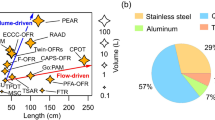Abstract
Fly ash was used as a model for ambient particulate matter which is under suspicion to cause adverse pulmonary health effects. The fly ash was pre-sized and contained only particles < 20 μm including an ultrafine fraction (< 100 nm) that contributed 31% to the particle number. In our study, we investigated the influence of fly ash on the promotion of early inflammatory reactions like the formation of reactive oxygen species (ROS) in rat lung epithelial cells (RLE-6TN). Furthermore, we determined the formation of nitric oxide (NO). The cells show a clear dose-response relationship concerning the formation of ROS with regard to the mass of particles applied. Lipopolysaccharide (LPS) added as a co-stimulus did not increase the formation of ROS induced by fly ash. Furthermore, in LPS (01 μg/ml) and tumour necrosis factor-alpha (TNF-alpha; 1 ng/ml) pre-treated cells no increase in reactive oxygen species comparable to fly ash alone is observable. In presence of the metal chelator, desferrioxamine (DFO), ROS formation can be significantly reduced. Neither fly ash nor LPS induced a significant NO release in RLE-6TN cells.
Similar content being viewed by others
Abbreviations
- BSA:
-
Bovine serum albumin
- DCF:
-
2′-7′-dichlorofluorescein
- DFO:
-
Desferrioxamine mesylate
- DMEM:
-
Dulbecco’s Modified Eagle Medium
- FCS:
-
fetal calf serum
- HBSS:
-
Hank’s balanced salt solution
- H2DCF:
-
2′-7′-dichlorodihydro-fluorescein
- IFN-gamma:
-
interferon-gamma
- iNOS:
-
inducible nitric oxide synthase
- MAF98:
-
fly ash used in this study
- LBP:
-
lipopolysaccharide binding protein
- LPS:
-
lipopolysaccharide
- MIP-2:
-
macrophage inflammatory protein-2
- NO:
-
nitric oxide
- ROS:
-
reactive oxygen species
- TNF-alpha:
-
tumour necrosis factor-alpha
- TPA:
-
12-O-tetradecanoylphorbol-13-acetate
References
Diabaté S, Muelhopt S, Paur H-R and Krug H F 2002 Pro-inflammatory effects in lung cells after exposure to fly ash aerosol via the atmosphere or the liquid phase;Ann. Occup. Hyg. 46 382–385
Dreher K L, Richard H J, Lehmann J R, Richards J H and McGee J K 1997 Soluble transition metals mediate residual oil fly ash induced acute lung injury;J. Toxicol. Environ. Health 50 285–305
Driscoll K E, Carter J M, Iyphe P T, Kumari H L, Crosby L L, Aardema M J, Isfort R J, Cody D, Chestnut M H, Burns J L and LeBoeuf R A 1995 Establishment of immortalized alveolar Type II epithelial cell lines from adult rats;In Vitro Cell Dev. Biol.-Anim. 31 516–527
Frey E A, Miller D S, Jahr T G, Sundan A, Bazil V, Espevik T, Finlay B B and Wright S D 1992 Soluble CD14 participates in the response of cells to lipopolysaccharide;J. Exp. Med. 176 1665–1671
Green L C, Wagner D A, Glogowski J, Skipper P L, Wishnok J S and Tannenbaum S R 1982 Analysis of nitrate, nitrite and [15N] nitrite in biological fluids;Anal. Biochem. 126 131–138
Lehnert B E 1993 Defense mechanism against inhaled particles and associated particle-cell interactions;Rev. Mineral 28 427–470
Papi A 1997 Epithelial ICAM-1 regulation and its role in allergy;Clin. Exp. Allergy 27 721–724
Pugin J, Schuerer-Maly C-C, Leturcq D, Moriarty A, Ulevitch R J and Tobias P S 1993 Lipopolysaccharide activation of human endothelial and epithelial cells is mediated by lipopolysaccharide-binding protein and soluble CD14;Proc. Natl. Acad. Sci. USA 90 2744–2748
Punjabi C J, Laskin J D, Pendino K J, Goller N L, Durham S K and Laskin D L 1994 Production of nitric oxide by rat Type II pneumocytes: increased expression of inducible nitric oxide synthase following inhalation of a pulmonary irritant;Am. J. Respir. Cell. Mol. Biol. 11 165–172
Schwartz J 1994 What are people dying of on high pollution days?;Environ. Res. 64 6–35
Simon R H and Paine R 1995 Participation of pulmonary alveolar epithelial cells in lung inflammation;J. Lab. Clin. Med. 126 108–118
Sies H 1985 Oxidative stress: Introductory remarks; inOxidative stress (ed.) H Sies (London: Academic Press) pp 1–8
Smith K R, Veranth J M, Lighty J S and Aust A E 1998 Mobilization of iron from coal fly ash was dependent upon the particle size and the source of coal;Chem. Res. Toxicol. 11 1494–1500
van Maanen JMS, Borm P J A, Knaapen A, van Herwijnen M, Schildermann P A E L, Smith K R, Aust A E and Tomatis M 1999In vitro effects of coal fly ashes: Hydroxyl radical generation, iron release, and DNA damage and toxicity in rat lung epithelial cells;Inhal. Toxicol. 11 1123–1141
Wan C P, Myung E and Lau B H S 1993 An automated microfluorometric assay for monitoring oxidative burst activity of phagocytes;J. Immunol. Methods 159 131–138
Author information
Authors and Affiliations
Corresponding author
Rights and permissions
About this article
Cite this article
Voelkel, K., Krug, H.F. & Diabaté, S. Formation of reactive oxygen species in rat epithelial cells upon stimulation with fly ash. J. Biosci. 28, 51–55 (2003). https://doi.org/10.1007/BF02970131
Published:
Issue Date:
DOI: https://doi.org/10.1007/BF02970131




